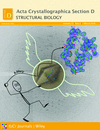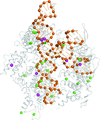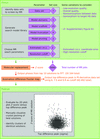issue contents
March 2016 issue
Advances in experimental phasing
Proceedings of the CCP4 Study Weekend edited by Charles Ballard, Airlie McCoy and Thomas Schneider

Cover illustration: Killing two (twin) birds with one stone: phasing of CdC23Nterm with a 4.6 keV X-ray beam (Cianci et al., p. 403).
introduction
Open  access
access
 access
accessAn introduction to the 2015 CCP4 Study Weekend on Advances in Experimental Phasing.
research papers
Open  access
access
 access
accessThe development of phasing methods in protein crystallography is presented.
Open  access
access
 access
accessThe benefits of using local scaling and optimization of anomalous signal (as implemented in PHENIX) for merging data sets from many crystals for determination of the substructure for weak anomalous scatterers are examined.
Open  access
access
 access
accessThis review summarizes the reasons why the heavy-atom derivatization of protein crystals can be useful, how to select heavy atoms, how to produce a heavy-atom-modified crystal that still diffracts and how to determine whether the protein has been modified.
Open  access
access
 access
accessThe structure of a eukaryotic ion channel solved using tantalum bromide SAD phasing is discussed in the context of basic challenges common to membrane proteins.
PDB reference: bestrophin-1, 4rdq
Open  access
access
 access
accessThe low-resolution structure determination of the COP9 signalosome, a large multi-protein complex, from crystals affected by rotational pseudo-symmetry and twinning is detailed.
Open  access
access
 access
accessA selenomethionine marker strategy allowed the identification of a region of disconnected electron density at low resolution and despite poor selenomethionine incorporation, thereby building a structural framework for understanding how the clathrin adaptor AP2 regulates clathrin binding in mammalian cells.
Open  access
access
 access
accessThe useful anomalous correlation and the anomalous signal in a SAD experiment are metrics describing the accuracy of the data and the total information content in a SAD data set and are shown to be related to the probability of solving the anomalous substructure and the quality of the initial phases.
Open  access
access
 access
accessAlgorithms for evaluating and optimizing the useful anomalous correlation and the anomalous signal in a SAD data set are described.
Open  access
access
 access
accessA new Rice-function approximation for the effect of intensity-measurement errors improves the treatment of weak intensity data in calculating log-likelihood-gain scores in crystallographic applications including experimental phasing, molecular replacement and refinement.
Open  access
access
 access
accessBoth site-specific radiation damage and heavy-atom derivatization result in small changes to the intensity of reflections. The size of the change owing to each is calculated and compared for individual reflections.
Open  access
access
 access
accessA case study of radiation-damage-induced phasing is discussed using ultraviolet light-emitting diodes to induce specific radiation damage.
Open  access
access
 access
accessData collection with a tailored 50 µm diameter X-ray beam at 4.6 keV (λ = 2.69 Å) on the newly established EMBL beamline P13 at PETRA III allowed the crystal structure determination of the Cdc23Nterm homodimer (65.4 kDa; 12 Cys and ten Met residues) by sulfur SAD phasing at 3.1 Å resolution while overcoming crystal twinning.
PDB reference: sulfur SAD phasing of Cdc23 APC subunit, 5ftp
Open  access
access
 access
accessBest practices in data collection for experimental phasing at the ESRF Structural Biology beamlines are described.
Open  access
access
 access
accessThe successful structure solution of the integral membrane diacylglycerol kinase and the CRISPR-associated endonuclease RNA–DNA complex by native SAD phasing is demonstrated. The structures were solved with a combined low-dose multi-orientation, multi-crystal data-collection strategy.
Open  access
access
 access
accessThe motivation for, and the first results from, the novel in-vacuum long-wavelength MX beamline I23 at Diamond Light Source are presented.
PDB reference: thaumatin, 4zg3
Open  access
access
 access
accessA strategy is presented to set up an n-dimensional molecular-replacement parameter matrix (MRPM) search using anomalous difference Fourier maps from related data sets to uncover weak, but correct, molecular-replacement solutions for heavy-atom substructure determination and subsequent experimental phasing.
Open  access
access
 access
accessNew developments in CrowdPhase, a collaborative online game for tackling the low-resolution phase problem, are presented. The new features address several crystallographic issues and extend the reach of CrowdPhase to a broader range of experimental data sets.


 journal menu
journal menu





































